WHAT YOU REALLY NEED TO KNOW
ABOUT COSMETIC SURGERY
Full Text from Dr. Berman's Book
Chapter 4
RHINOPLASTY
(Nasal reconstruction)
Nasal surgery has evolved significantly since the days of the "nose job". Not only have the perspectives on cosmesis been refined, but so have the views on it as a functional organ. The nose is probably one of the most poorly understood and appreciated parts of our body. It has an extremely important role as a respiratory organ. Indeed, aside from good genes and good luck, I firmly believe that the three most essential criteria for good health are a healthy low fat diet, adequate exercise, and an open nasal airway, particularly during sleep.
As a cosmetic component to the face the nose has an interesting position. Most people like the idea of having a classically pretty or handsome nose. However, the eyes and the mouth are the main objects of focus and consequently the main indicators of beauty. When a nose blends harmoniously with the face, it does not distract from the positive features of the eyes and mouth. When someone communicates with you, it is their eyes and mouth that display their expressions and emote their feelings. The nose is capable of little expression. However, if there is some element about the nasal shape that is distracting and takes our attention away from the inherent beauty of the individual, then our goal should be to reshape it so it blends more harmoniously with the rest of the face. Indeed, it should be shaped ultimately to please the patient, but its reshaping does not have to be limited to one particular style. Also, it is important to realize that the shape of the chin and the cheeks often have as much influence on the appearance of the face as does the nose. A weak chin or weak cheek bones often make the nose look larger than it really is. At any rate, the important issue is to customize the nasal surgery so the ultimate result looks like the nose that belongs on the patient's face. Nasal surgery is most typically performed when the patient and the tissues are adequately mature. Though we commonly wait until 15 or 16, there are cases when younger, fully grown children may be appropriately ready for rhinoplasty. Self esteem in the teen years is still largely based on appearance. It seems a shame to make a teen go all through high school before correcting a fully grown disharmonious nose.
In discussing changes of facial contour (i.e. nose, cheeks, and chin in particular), computer imaging is almost always utilized. Its goal is not to sell the surgery nor to guarantee a particular result. It is to help understand what to expect and what the doctor can achieve. Don't forget, the key to surgery is a result that makes the patient happy. By demonstrating the proposed result prior to surgery, with the patient's input available, one maximizes the likelihood of a positive outcome. Indeed, the aspect of surgery itself runs the risks of imperfect outcomes, but a minor revision 6 months later in a small percentage of patients is better than a completely unexpected and unwanted result.
As for the nasal airway, it is a vital part of good health. The nose has several functions, not the least of which is to warm and humidify the air before it gets to the lungs. Internally, the nose is made of two chambers in parallel with a very large surface area of mucous membranes which envelope the bony and cartilaginous skeleton. Thus, as you breath in through your nose the air is expeditiously warmed and humidified. Surgery on the nose is done with the attitude of maintaining a good airway or improving a bad one. The type of surgery done often causes some narrowing to the nasal chamber, but the patency of the airway can be maintained and improved in spite of this. Many times the patient presents significant airway obstruction to begin with. Often this is functional in nature, caused by swelling of the nasal mucous membranes. This can be caused from allergy, simple irritations such as smoke or smog, and from changes in body or environmental temperatures to site a few examples. In such cases, treatment may involve medications or allergy treatments and such will be prescribed when necessary. In other cases there may be structural abnormalities which are blocking the airways. Surgical repair of the septum may be necessary. Additionally, enlarged and obstructive turbinates (bony projections covered with mucous membrane and stemming from the side walls of the nose) may require reduction often effected with the KTP laser.
Nasal surgery, whether for improvement of appearance or function, is done through incisions placed on the inside of the nasal chamber. There are no visible scars, although in special circumstances an incision can be may placed on the collumela (midsection between the nasal tip and upper lip) or even in the groove of the nostrils to reduce flaring. I prefer the use of local anesthesia with intravenous sedation when performing the procedure. There are doctors who prefer general anesthesia, however, I find it rarely necessary. With today's good sedation techniques, properly administered local anesthesia provides a more comfortable post-operative course, less bleeding, and less risk of complications from general anesthesia.
The surgical process involves separating the skin and mucous membranes from the bony and cartilaginous parts of the nose. The nasal bones and cartilages can then be trimmed, re-shaped, or augmented in order to appropriately re-shape the nasal appearance. The skin then redrapes over the new nasal skeleton and is secured in place with dissolvable sutures.
After the surgery a plaster or plastic splint is secured to the nose. This serves not only to protect the nose from mild bumping, but mainly to secure the nasal bones in proper position.
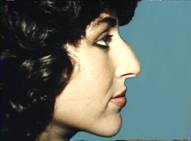
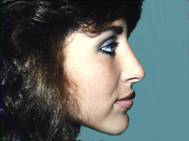
Typical kind of reduction rhinoplasty where the patient has a moderate hump deformity. By lowering the nasal dorsum the nose is more harmonious the rest of the face.
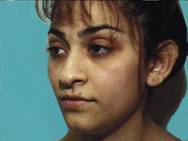
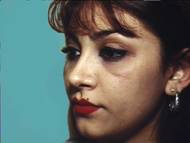
Sometimes the tip is disharmonious with the shape of the nose. In this case, the tip was raised and contoured in addition to slight narrowing to the bridge. The element of distraction is thus removed.
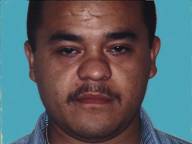
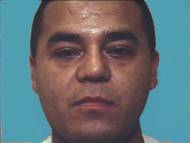
In this example, a young man presents with a short, flat nasal tip that looks out of place. By building up the nose and reconstructing the tip, his nose seems to "fit" on his face. The major element of distraction is removed.
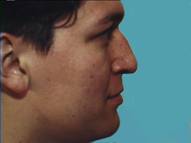
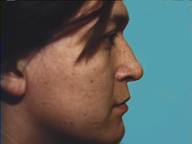
In this example, the patient appears to have a typical hump deformity, but in actuality, has a droopy nasal tip. Because the tip has poor support, internal cartilage grafting, as is done in many cases, helps to position the tip in a more aesthetically pleasing position. No changes were made to the bony nasal dorsum.
Because the healing process continues for several months one can expect initial swelling to subside and gradual changes to continue months after surgery. Nonetheless, the greatest changes will be realized within the first few weeks.
The nose will be very tender while it is healing. While a bump on the nose should not be enough to do any real damage one can expect to see stars. While the patient will eventually get used to their new nose feeling a little numb or "wood-like", they will be pleased to know that four to six weeks later it should return to feeling rather normal. If any revisions need to be made, they are usually done after six months from surgery.
Early complications are unusual, but occasionally bleeding may occur necessitating the placement of nasal packs. Nasal packs which used to be routine at the time of nasal surgery are being used much less frequently in most cases. I rarely pack the nose at time of surgery. Infection is also a very rare complication of nasal surgery. It rarely manifests as an acne lesion which might smolder under the splint and is rarely of any consequence. Post-operative swelling and scar tissue formation may be greater in certain individuals. It may be treated by injections of anti-inflammatory steroids. Finally, as noted, untoward results in the healing process or the operation itself may result in slight irregularities which might require a touch-up procedure.
Not to be forgotten, good nutrition and proper care for the healing nose will help the patient achieve optimal results.
Fees for nasal surgery may depend on how much work needs to be done.